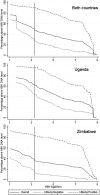Hepatitis B serological markers and plasma DNA concentrations
- PMID: 28328795
- PMCID: PMC5414544
- DOI: 10.1097/QAD.0000000000001454
Hepatitis B serological markers and plasma DNA concentrations
Abstract
Objectives: To examine hepatitis B (HBV) serological markers and plasma DNA concentrations in a large group of untreated HBV/HIV-coinfected individuals in two sub-Saharan settings.
Design: Baseline analysis of a randomized controlled trial.
Methods: DART was a large trial of treatment monitoring practices in HIV-infected adults with advanced disease starting antiretroviral therapy at centres in Kampala or Entebbe, Uganda (n = 2317) and Harare, Zimbabwe (n = 999). HBV serological markers [antibody to HBV core antigen, HBV surface antigen (HBsAg), antibody to HBV surface antigen, HBV 'e' antigen (HBeAg), and antibody to hepatitis B 'e' antigen] and plasma HBV DNA viral load were measured retrospectively on stored baseline samples. Logistic regression was used to examine associations with baseline demographic and clinical factors.
Results: The rate of HBsAg positivity was significantly higher in Zimbabwe than Uganda (12.2 vs. 7.7%, adjusted odds ratio = 1.54, P < 0.001) despite a similar prevalence of antibody to HBV core antigen (56.3 vs. 52.4%) in the two settings. Overall, HBsAg positivity was associated with male sex (adjusted odds ratio = 1.54, P < 0.001) but not with age, WHO disease stage, or CD4 cell count. HBeAg was detected among 37% of HBsAg-positive patients, with higher rates among those with advanced WHO stage (P = 0.02). Also in HBsAg-positive patients, HBV DNA was undetectable in 21%, detectable but below the level of quantification in 14%, and quantifiable in 65%. A total of 96% of HBeAg-positive and 70% of HBeAg-negative patients had detectable HBV DNA; 92 and 28% of patients, respectively, had HBV DNA viral load more than 2000 IU/ml.
Conclusion: High rates of HBV coinfection were observed, highlighting the importance of ensuring that coinfected patients receive an antiretroviral regimen, whether first-line or not, that is active against both viruses.
Figures
References
-
- Lewden C, Salmon D, Morlat P, Bevilacqua S, Jougla E, Bonnet F, et al. Causes of death among human immunodeficiency virus (HIV)-infected adults in the era of potent antiretroviral therapy: emerging role of hepatitis and cancers, persistent role of AIDS. Int J Epidemiol 2005; 34:121–130. - PubMed
-
- Weber R, Sabin CA, Friis-Moller N, Reiss P, El-Sadr WM, Kirk O, et al. Liver-related deaths in persons infected with the human immunodeficiency virus: the D:A:D study. Arch Intern Med 2006; 166:1632–1641. - PubMed
-
- Thio CL, Seaberg EC, Skolasky R, Jr, Phair J, Visscher B, Munoz A, et al. HIV-1, hepatitis B virus, and risk of liver-related mortality in the Multicenter Cohort Study (MACS). Lancet 2002; 360:1921–1926. - PubMed
-
- World Health Organization. Consolidated guidelines on the use of antiretroviral drugs for treating and preventing HIV infection: recommendations for a public health approach. Geneva: World Health Organization; 2013. - PubMed
Publication types
MeSH terms
Substances
Grants and funding
LinkOut - more resources
Full Text Sources
Other Literature Sources
Medical
Research Materials



